Hi, my name is Michael and I have a confession to make: I’m a comic geek. Better (or worse) yet, I’m also a TCG player. As such, when Vs. System debuted in 2004 with Marvel Origins, I experienced something akin to pure bliss. Vs. System succeeded where so many comic-inspired games before it had failed, perfectly fusing flavor and function to create a game that was fun and faithful to the source material. The elation I experienced when I first opened my X-Men vs. Brotherhood starter deck continues to this day, and I look forward to playing Vs. System when I’m eighty.
Welcome to the first article in my new weekly series! My column is entitled Living Ink, because I love the way Vs. System brings my favorite comic book characters to life and enables me to enjoy them in a whole new way. Each week, I will focus on one character from the current set, briefly outlining its powers, personality, and comic book history, and then discus how the designers at UDE instilled the flavor of the comics into those marvelous little pieces of cardboard.
Before I swing into action, I quickly want to acknowledge that this series is in part inspired by the work of James Paraha. James wrote a short-lived series called On the Face of Things for vsparadise.com. Sadly, due to work and family commitments, James couldn’t continue to write these articles. Thankfully, he has given me his blessing to adapt his idea for Metagame.com. I urge you all to visit the archives at vsparadise.com and check out James’s work. You’ll see that I have a lot to live up to.
Now, most of you probably played in one or more Marvel Team-Up Sneak Preview tournaments over the weekend. Perhaps the most notable thing about Marvel Team-Up is that it sees the Vs. System return of the amazing Spider-Man and his many friends.
Spider-Man first appeared in Marvel’s Amazing Fantasy #15 in August 1962. Since then, Spidey has become one of the most recognizable and beloved comic book characters ever. He has actually transcended his original genre and moved into the popular consciousness. It might be hard to find a random person on the street who knows who Nightwing and Black Panther are, but you’ll be hard pressed to find many people who don’t know Spidey. Most will tell you that his alter-ego is Peter Parker, that he works as a photographer at The Daily Bugle, and can probably even describe his costume.
Perhaps the biggest secret to Spidey’s success (including two movies in the top ten all-time US box office earners) is that Peter Parker is a young man suffering problems to which his audience, particularly young males, can personally relate. Who can really connect with what it’s like to be the sole survivor of a dead alien civilization or a billionaire vigilante? But Spidey’s main problems involve prioritizing his school, work, home, and personal commitments, just like you and I.
Peter was raised by his Aunt May and Uncle Ben in Queens, New York. As a teenager, Peter was a genuine nerd (something else that many of us could relate to) who was into science and photography. This passion for science led him to attend a science exhibition where he was bitten by a radioactive spider (see Twist of Fate). Instead of getting radiation poisoning, cancer, and maybe a slight case of death, Peter developed amazing spider-like powers, including the equivalent strength of a spider, preternatural agility, the ability to “wall-crawl,” and his famous Spider Senses. Being a science whiz, Peter also invented Web Shooters, which allow him to spin webs to swing from and to bind bad guys with (see Gift Wrapped).
These developments, however, did not immediately draw out Peter’s inner hero. Taking the identity of Spider-Man, Peter initially tried to use his powers to earn fortune and fame as a wrestler. Following a television appearance, Spider-Man made no effort to stop a buglar who was robbing the station. Simply put, it wasn’t his problem. This error in judgement came back to haunt him when that same buglar killed his Uncle Ben (see Tragic Loss). Only then did Peter understand the lesson his uncle had tried to teach him earlier: “With great power there must also come great responsibility.”
Peter then took a freelance photographer job at the Bugle, working for the demanding J. Jonah Jameson. Juggling school, work, super heroics, and maintaining a secret identity made for a very busy life. Over the course of forty-four years in comics, a lot has happened to Spidey, including college, the death of loved ones, careers, marriage, fatherhood, more death, cloning shenanigans, and a whole bunch more, yet Peter Parker’s original appeal remains intact—he is an “everyman” hero who injects humor into the most dire of situations and never, ever gives up.
With the arrival of Marvel Team-Up, there are twelve versions of Spider-Man, which is currently two more than Superman and three more than Wolverine. This alone is a testament to Spidey’s popularity and importance in comic book history. So, how do the Vs. System incarnations of Spider-Man stack up to the comics?
At this point, keep in mind that not all cards are designed “top down” (way back in May 2004, Danny Mandel explained “top down” design ), so it’s not reasonable to expect every character card I examine in this series to be a perfect representation of a character or story in the comics. I think we’ll find that UDE has done a great job on the flavor-front regardless of whether the following cards were designed “top-down” or “bottom-up.”
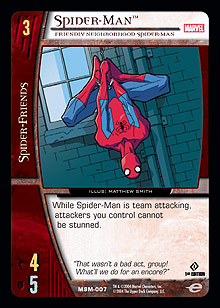
Spider-Man, Friendly Neighborhood Spider-Man is one of the two 3-drop versions of our hero. Traditionally, when the same character has multiple versions, the lower costed cards represent that character earlier in his or her career. So, we might theorize that here we have a younger Peter who is still learning the ropes. The fact that Spidey is the flagship character of the new Marvel Team-Up set (which is named after a comic book series in which Spidey teamed-up with a different hero every month) is indictative of the fact that, while he might seem like a loner, Spider-Man is actually an excellent team player. A power that kicks in whenever Spidey team attacks perfectly captures that flavor. Similarly, being difficult to stun reflects Spider-Man’s extraordinary agility.
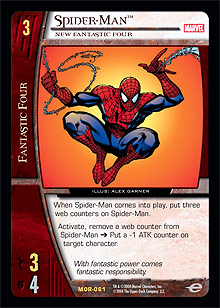
Spider-Man, New Fantastic Four is the other 3-drop, and was the first incarnation of Spidey we ever saw in Vs. System. This card specifically references a storyline featured in Fantastic Four #347-349, published from December 1990 to February 1991, in which Spidey, Wolverine, Hulk, and Ghost Rider form a new Fantastic Four after having been tricked into thinking the originals were dead. This Spidey’s power nicely represents the character’s use of webs to hinder his opponents. Furthermore, having only three web counters shows that Spidey often used to run out of web-fluid . . . sometimes right in the middle of a fight. His ATK and DEF look a bit low for a character of his caliber, but considering that he’s on a team with access to Cosmic Radiation, it may have been necessary to ensure that he was well balanced.
Spider-Man, The Amazing Bag-Man is one of four 4-drop Spider-Men in Marvel Team-Up that utilize the substitute mechanic. While this version of Spidey’s power reminds me once again of his webbing and his ability to neutralize a couple of opposing characters even when he’s beaten in a fight, I think it’s the version name and artwork that will draw my fellow fanboys’ attention. In Amazing Spider-Man #258, published in November 1984, Peter had to fight off the negative influence of his black costume, which turned out to be an alien symbiote (see Spider-Man, Alien Symbiote and Spider-Man, Parasitic Host below). The problem with getting into a fight with your wardrobe is that if you win, you’re probably naked. This is the situation Spidey found himself in. With a borrowed Fantastic Four uniform and a paper bag with eye-holes cut into it, Peter was able to get home clothed and without compromising his secret identity.
Spider-Man, Parasitic Host is another Spidey 4-drop from Marvel Team-Up. Once again, Spidey’s payment power reflects his ability to bind his enemies with webbing. Furthermore, the version and artwork represent our hero at the point of his career when he was under the influence of an alien symbiote, which Peter would eventually rid himself of, only to have it bond with a Bugle reporter and create Venom, Eddie Brock. The black costume first appeared in Marvel Team-Up #141, Amazing Spider-Man #252, and Spectacular Spider-Man #90 in May 1984. The costume was initially a boon to Spidey, as it responded to his thoughts, greatly enhanced his powers, provided him unlimited web-fluid, and could change its appearance. The camouflage ability in particular is nicely represented on this card as concealed—optional.
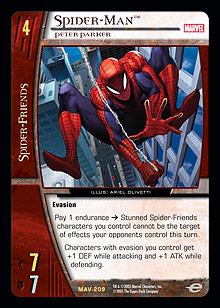
To me, Spider-Man, Peter Parker represents Spidey when he’s really starting to find his feet as a superhero, which I believe is supported by his resource cost. Both of his powers show that Spider-Man is a good guy to have on your team. He provides a stat boost to your other characters with evasion, and his payment power helps protect his team when it might otherwise be vulnerable. This is Spidey in his ascendancy. A bit of a loner on the face of things, it shows that Peter actually has great, natural leadership qualities and can be the lynchpin of a team. Furthermore, an Extended Art version of this card (given exclusively to UDE employees) painted by Alex Ross features Spider-Man protecting then-girlfriend Gwen Stacey from the Green Goblin. The Green Goblin murdered Gwen in The Amazing Spider-Man #121, published in June 1973, in one of the most important and impactful stories in Spidey’s history.
Spider-Man, The Sensational Spider-Man is yet another Marvel Team-Up 4-drop with substitute. He is also one of the many versions of Spidey named after the various nicknames developed for the character over the years, many of which were used as titles for the comic books that Spidey starred in. Like many of the other versions of Spider-Man, this version has an exhaustion-themed power.
Spider-Man, Spider-Hulk is the final Marvel Team-Up Spidey 4-drop, and the version name pretty much sums it up. In Web of Spider-Man #70, published in November 1990, Spidey gets big, mean, and green after receiving a dose of bio-energy from the Hulk, Gamma Rage. “SPIDER SMASH!” The card effectively represents the beefiness that hulking up provides, and making it a cosmic power reflects the fact that the transformation is short-lived and that Spidey will return to normal before too long.
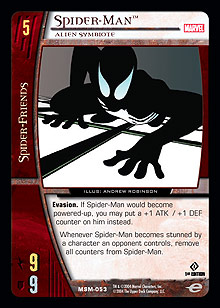
Spider-Man, Alien Symbiote is Spidey’s sole 5-drop version. Similar to Spider-Man, Parasitic Host, this card shows Spidey wearing his black costume. I like to think of this card as showing Peter shortly after he got the suit, when he was still learning about its abilities but before he realized the danger it represented. He has evasion, which reflects how agile Spidey is and how hard it can be to put him down. Otherwise, I think this is a good example of “bottom down” design. One of the main themes of the Spider-Friends team in Web of Spider-Man was cloning. In one of the most controversial and ultimately unpopular Spider-Man storylines, it was revealed that Peter was cloned by the Jackal in Amazing Spider-Man #141–151 during the 1970s. All of these clones turned up again in the 1990s. The first, flawed clone was named Kaine and another called himself Ben Reilly (see Scarlet Spider). Fans were shocked to learn that Ben was actually the real Spider-Man and Peter was the clone, which led to Peter stepping aside and Ben taking up the mantle for a period of time. Later, all was returned to normal, but Marvel fans have never stopped reminding the company of how much they disliked the whole thing. Unpopular or not, though, the Clone Saga was an important part of Spidey’s life, and I love the way UDE represented it in Vs. System. They gave us the means to make Spidey non-unique, meaning we could get multiple copies of him into play at the same time. This is where Spider-Man, Alien Symbiote might have been designed “bottom down,” as his power provides players a gameplay bonus for putting so many copies of Spider-Man in their decks.
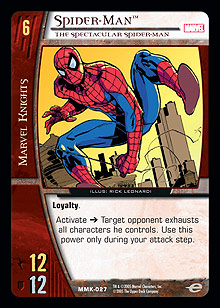
Spider-Man, The Spectacular Spider-Man is our Spidey 6-drop. Sadly, he suffers somewhat from the fact that dual affiliations weren’t around prior to the Justice League of America set: not only isn’t he a Spider-Friends character, but he also has loyalty for the Marvel Knights team! This last part may have a lot to do with how spectacular his power is, as he can web up your opponent’s whole board. Balance is such an important element of our game that you can’t fault the designers for that one.
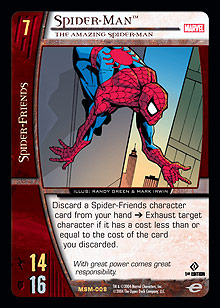
Spider-Man, The Amazing Spider-Man is perhaps the most perfectly designed Spider-Man in Vs. System from a flavor point of view. There aren’t too many decks that will include a 7-drop character, and his payment power marks him as one of the most powerful cards in our game. Once again, we see Spidey exhausting opposing characters, but this time he can do it off-initiative, multiple times, and without needing to activate. The Amazing Spider-Man is the longest running Spider-Man comic book, so the version for this character couldn’t be more appropriate.
Spider-Man, Stark’s Protege is one of the big hitters in the new Marvel Team-Up set. This card specifically represents Spidey as seen in very recent comics. Spidey joined the New Avengers, built a close relationship with Iron Man, Tony Stark, and initially sided with Tony during the current Civil War storyline. Iron Man even provided Peter an “Iron Spider-Suit,” which raised many eyebrows. Once again, we have exhaustion as a payment power, although unlike his amazing counterpart, he can only do his trick once per turn. I think loyalty is a nice touch of flavor, even if it is there strictly for gameplay reasons, as issues surrounding Spidey’s allegiances have been an important issue in Civil War.
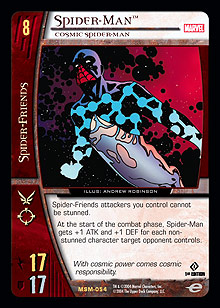
Spider-Man, Cosmic Spider-Man is the big daddy of all Spider-Man cards. In fact, cosmic Spidey has the potential to be the biggest 8-drop in the whole game! In The Spectacular Spider-Man #158 and The Amazing Spider-Man #329, the Uni-Power imbued Spidey with cosmic energy, transforming him into Captain Universe. This amped his power to extraordinary levels. The foil version of the card comes with great flavor text: “With cosmic power comes cosmic responsibility.” This is a fanboy dream come true.
And that’s it. On the whole, I believe that UDE has been remarkably successful in replicating Spider-Man’s flavor and history into our favorite TCG, but I’d be happy to hear your thoughts if you’d like to send me an email at ikeebear@hotmail.com.
This has been a very long article, and I thank those who have worked all the way through this epic. I promise future articles will be more modest in length, especially as the other characters on my hit list don’t have twelve different versions!
Finally, I’d like to leave a short recommended reading list of Spider-Man comics that might help enhance your enjoyment of the Spider-Man Vs. System cards:
· Amazing Spider-Man #248 (1984) – “The Kid Who Collects Spider-Man” (republished as part of Wizard Best of Spider-Man Limited Deluxe Hardcover)
· The Amazing Spider-Man (Vol. 1) #121-122 (1973) – “The Night Gwen Stacy Died” (republished in Spider-Man: Death Of Gwen Stacy TPB)
· Web of Spider-Man #31-32, Amazing Spider-Man #293-294, and Spectacular Spider-Man #131-132 (1987) – “Kraven’s Last Hunt” (republished in Spider-Man: Kraven’s Last Hunt Hardcover)
· Spider-Man’s Tangled Web #5-6 (2001) – “Flowers for Rhino”
· Ultimate Spider-Man #1-7 (2000-2001) – “Power and Responsibility” (republished in Ultimate Spider-Man Vol. 1 TPB)
See you in the funny pages,
Michael Pittman
ikeebear@hotmail.com